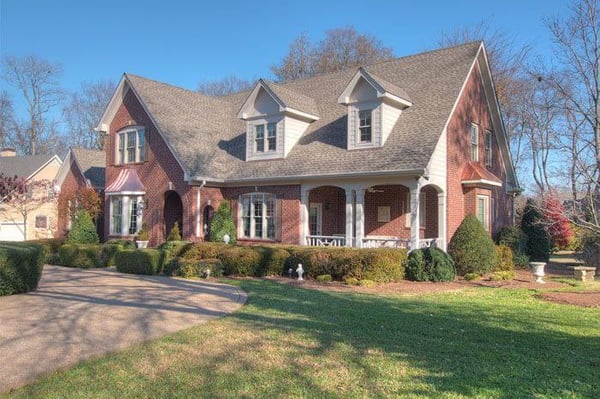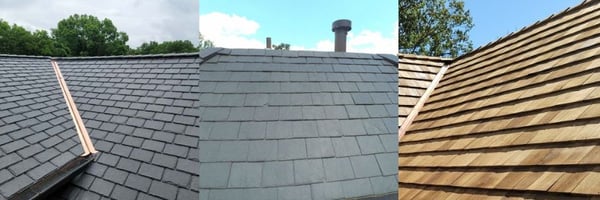The roofing material you choose has a huge impact on the price of your new roof, how long it’ll last, and much more. This makes picking a roofing material for your roof replacement a big decision.
Apart from hiring a roofing contractor, it’s actually the most important decision you’ll have to make. So, you want to be sure you’re making the best choice for your specific situation.
But how do you make this decision without experiencing buyer’s remorse?
For over 30 years, the team at Bill Ragan Roofing has helped homeowners find the perfect material fit for their upcoming roof replacement. Now we’ll help you narrow down the roofing material choices by simply considering some things.
In this article, you’ll go through 6 factors you need to consider when starting the decision-making process. I also include examples and comparisons of different roofing materials to help kickstart your decision.
1. The pitch of your roof
The first factor you need to consider is the steepness (angle) of your roof, also called roof pitch. Roof pitch is a ratio calculated by the number of inches or feet it rises vertically for every 12 inches or feet it extends horizontally.
For example, a roof with a 4/12 pitch will be 4 inches (or feet) up for every 12 inches (feet) out. You need to consider this because certain roof pitches require specific roofing materials.
For example:
If your roof is a 2:12 or lower, it’s considered a low slope roof. Well, the minimum roof pitch for shingles is 2:12 because they aren’t meant to hold or have sitting water on them.
Because of this, shingle manufacturers’ installation instructions and building codes state you can’t install asphalt shingles on a roof with a pitch below 2:12. This means you’ll have to choose a roofing low slope or flat roofing material.
The most popular low slope or flat roofing options include PVC, EPDM, TPO, and standing seam metal roofing. While this is definitely a factor you should consider, I don’t recommend getting on your roof to measure its pitch.
2. Your roofing material budget
No matter the roofing material, a roof replacement will always be expensive. However, the roofing material you choose has a huge impact on the price.
That’s why you need to determine your budget and how much you’re willing to spend on your new roof. The budget you set greatly narrows down your roofing material choices.
For example:
An asphalt shingle roof is the best option for homeowners looking for affordability. This affordability is why architectural asphalt shingles are the most popular type of roofing material used in the country.
If you have a bigger budget, you could consider a premium roof system that offers more benefits. However, the price jump could be significant.
If you want to upgrade to a luxury asphalt shingle, it’ll be around double the price of an architectural asphalt shingle. If you’re interested in a standing seam metal roof, it’ll cost more than triple the price of an architectural asphalt shingle.
Once you get to composite (synthetic) shingles, cedar shakes, and slate tiles, you’re looking at roof systems most homeowners can’t afford.
The important thing is not to break the bank when choosing your roof material. Find the one that fits your budget and make sure to invest in quality on the specific roof system.
3. How long you want your roof to last
The return on your roof investment is the number of years you get out of it. That’s why you need to consider a roof’s lifespan and how long it’ll last.
The 3 types of asphalt shingles have a lifespan range of around 20-30 years, depending on which one you choose. A cedar shake roof’s lifespan is also around 30 years, but it can get up to 50 years if you live in an area with the right conditions and climate.
If you’re looking for a little more durability and longevity, a composite (synthetic) shingle roof (40-50 years) and a standing seam metal roof (50 years) are great options. But if you’re looking for the longest-lasting roof system, a slate roof has a lifespan of 75 to 100 years.
The lifespans above won’t be exact due to the different factors that impact a roof’s life. But as long as you invest in quality materials and hire a great roofing contractor, your roof should get close to the maximum lifespan, no matter which material you choose.
4. The warranty you get on the roofing material you choose
You get two types of warranties on a new roof after installation. You’ll have one on the materials and one on your roofing contractor’s workmanship.
The workmanship warranty depends on your specific roofing contractor, but every roofing material offers a different type of material warranty. That’s why you need to consider how important the roofing material warranty is to your decision-making process.
All three asphalt shingles have a warranty on the materials themselves. Depending on which one you choose, they come out of the package with a 25 to 30-year prorated warranty.
But architectural and luxury asphalt shingles also have the option for an enhanced 50-year non-prorated warranty. On the other hand, a steel standing seam metal roof has a 30-year warranty on the Kynar 500 painted finish instead of the actual metal panels.
A composite (synthetic) shingle roof usually comes with a lifetime limited material warranty that will prorate after a certain number of years. However, the actual length of the material warranty depends on the specific manufacturer.
Natural materials (cedar shake or slate) don’t come with a material warranty because they naturally occur and aren’t made by a manufacturer. This only leaves your roofing contractor’s workmanship warranty to rely on if there’s ever a problem.
5. The curb appeal each roofing material offers
No matter what, a new roof improves your home’s curb appeal. But the type of roofing material you choose determines how much it boosts your home’s look.
That’s why you need to consider how important your home’s curb appeal is when making your final decision. An architectural asphalt shingle roof is the most commonly seen nationwide and makes a good-looking roof.
 (Architectural asphalt shingle roof)
(Architectural asphalt shingle roof)
But it’s installed on most roofs, so it doesn’t make your home stand out from the rest of your neighborhood. I recommend going with an architectural asphalt shingle roof if curb appeal isn’t important to your decision-making process.
.jpg?width=600&height=200&name=Featured%20Images%20(23).jpg) (Left: luxury asphalt shingles; Right: standing seam metal)
(Left: luxury asphalt shingles; Right: standing seam metal)
If you want to take it to another level, a luxury asphalt shingle roof or standing seam metal roof are great options. Even if you don’t want a full metal roof, you can add a metal accent to your asphalt shingle roof to raise its curb appeal a little bit more.
 (Left to right: synthetic slate shingles, slate tiles, cedar shakes)
(Left to right: synthetic slate shingles, slate tiles, cedar shakes)
But if you’re looking for the best-looking roofs on the market, you should consider a composite (synthetic) roof, cedar shake roof, or slate roof.
6. How much maintenance each roofing material needs
Just like your car needs an oil change, your roof needs general maintenance. Roof maintenance is the periodic checking of all the vulnerable areas of a roof that could be susceptible to having a problem.
Each roofing material requires maintenance at some point throughout its life. However, the one you choose determines if you’ll need annual, biannual, or quarterly maintenance. That’s why you need to consider how often you want to have to worry about getting maintenance inspections.
No matter which type of asphalt shingle you choose, I recommend getting at least an annual inspection. The same goes for composite (synthetic) shingles and cedar shakes, mainly because of the premium investment you’ll have to make in these materials.
On the other hand, virtually no maintenance is required after a standing seam roof is installed. I still recommend checking it out yearly, but you can get by with a biannual maintenance inspection.
At the end of the day, roof maintenance ensures you maximize your roof investment. That’s why I always recommend yearly maintenance, even if it’s precautionary.
Want a guide to help you choose the right roofing material?
Now you know 6 factors to consider when choosing a roofing material for your replacement. While these considerations are important to the decision-making process, you can’t truly choose the right one for you based on this article alone.
Now, you can keep researching the different types to find the perfect fit. But this can be time-consuming and leaves you with a lot of information to digest with no way to refer back to the source material.
Wouldn’t it be great if all of the information for these materials were in one place for you to easily download?
That’s exactly what the Complete Guide to Purchasing a Roof is for. The free buyer’s guide includes the advantages and disadvantages of each roofing material, plus how much they cost, and so much more.
Since 1990, the team at Bill Ragan Roofing has provided high-quality roof replacements to homeowners in Nashville and surrounding Middle Tennessee areas. We work with you and your budget to get a beautiful new roof that’s protected by our lifetime workmanship warranty.
If you’re local to Nashville, Franklin, Brentwood, Belle Meade, and another surrounding Middle Tennessee area, don’t hesitate to Contact Us to get the beautiful roof you deserve.
Here’s your Complete Guide to Purchasing a Roof so you have the power to choose the right roofing material for your upcoming roof replacement.



